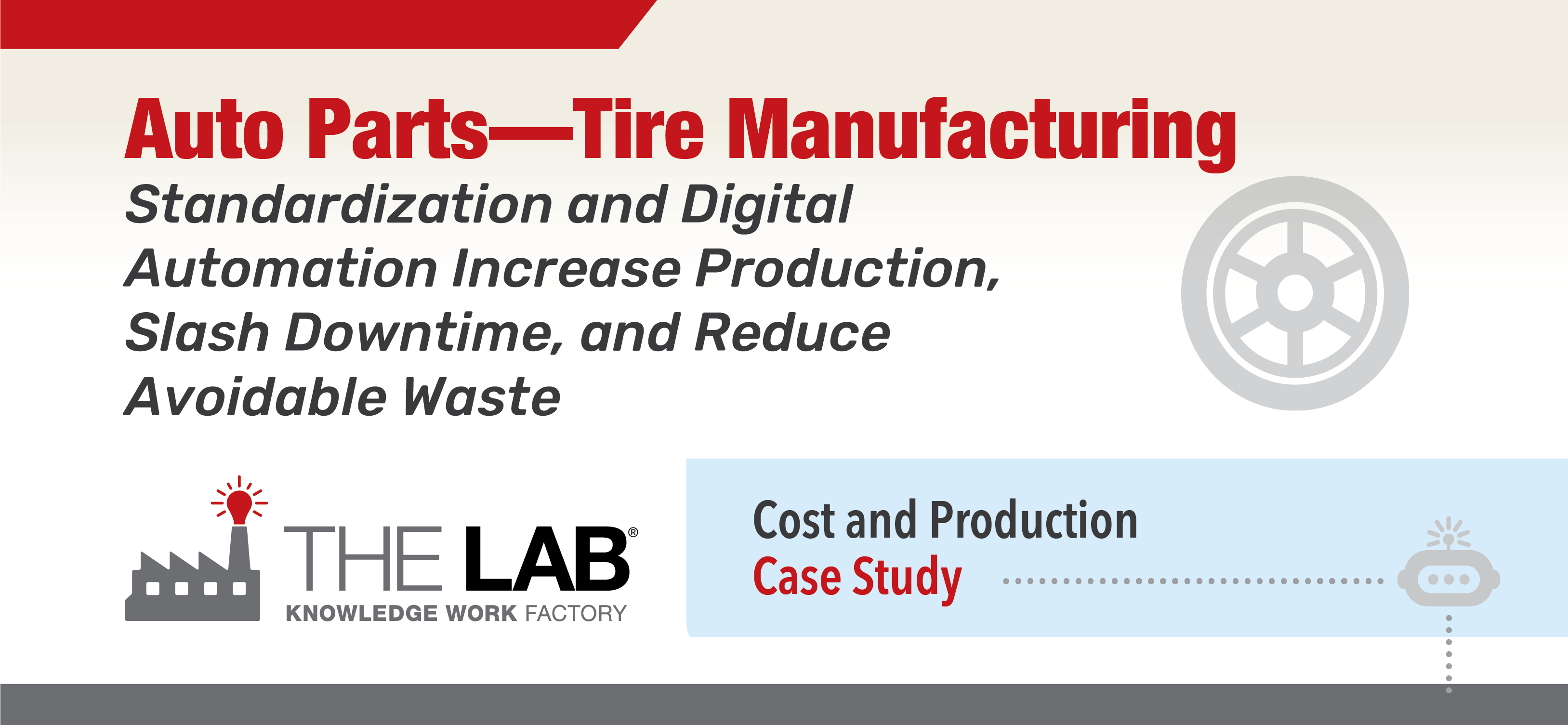Project Background
The company, a top-3 global tire manufacturer, was battling low-cost competitors who were overtaking the low-price end of the North American tire after-market. At the high-price end, effective marketing operations, high-quality product, and strong brand recognition kept these new entrants at bay. Even so, high-end customers pushed for lower pricing. Industry margins were so thin that a one-percent cost reduction could deliver a meaningful competitive gain in market share.
Corporate execs commissioned a cost benchmarking study by a prestigious strategy-consulting firm. Although light on specifics, the findings vaguely indicated an opportunity to reduce manufacturing costs by 20 percent. Skeptical of the number, senior management cut this figure in half and issued a directive to increase productivity by an aggressive 10 percent—quickly, without capital investment.
Operations executives were frustrated. Production equipment was nearly state-of-the-art. And they maintained numerous, internal, lean consulting teams at every plant. They believed they had exhausted every opportunity to increase employee productivity on the plant floor. The group was out of new ideas.
As they considered stepping up investment in existing approaches, the Senior Vice President of production operations for North America pointed out that knowledge worker processes always escaped scrutiny.
Daily experience proved that these non-plant processes directly influenced shop-floor productivity: schedule changes, production targets, and more. Executives felt there might be opportunity in looking at plant operations in this more broadly-defined context. The SVP contacted The Lab to learn more about knowledge work standardization.
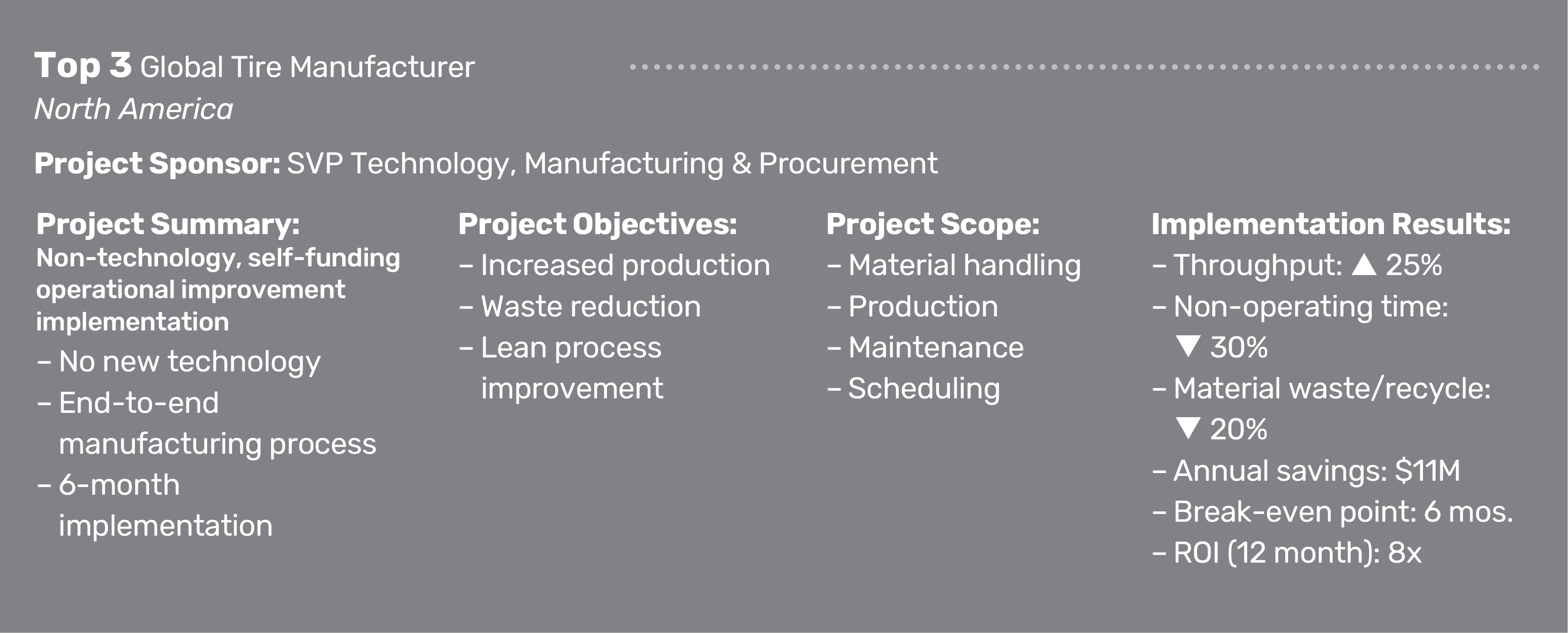
Client Description, Project Scope, Objectives
For over a century, the company has operated production plants around the world, supplying original equipment to manufacturers and replacement products to aftermarkets. Management routinely acquired the latest technology for manufacturing production, as well as operations management, e.g.,
The initiative began with an eight-week Phase I analysis covering end-to-end operations and business processes, including:
• Enterprise resource planning (ERP)
• Scheduling
• Shop-floor management
• Maintenance
• Logistics
• And many more
The SVP and his management team directed The Lab’s initiative toward its newest, most efficient U.S. facility, staffed by over 1,500 employees.
Executives embraced lean management methods pioneered by Toyota in the 1970s.
However, they conceded that execution in North America was not as disciplined as other parts of the world. And these methods had always been plant-floor focused. They’d never been broadly applied, end-to-end, across the enterprise to include both knowledge work as well as production work. Consequently, this became the scope of initiative.
To develop this comprehensive documentation, the scope included inputs and interactions across the organization that also influenced this plant:
• Sales and Operations Planning (S&OP)
• Network product-to-plant allocations
• Capacity planning
• Productivity targets
• Others
The Lab’s standardization improvement templates rapidly documented end-to- end business processes in granular, activity-level detail—within weeks.
Overview: Phase I, Analysis and Discovery
The initiative began with an eight-week Phase I analysis covering the major end-to-end business processes for plant operations, as well as selected non-plant, “knowledge work” business processes, including:

The Lab’s database of standardized documentation tools, termed Structured Discovery Templates™ (SDTs), enabled rapid comparison and assessment of the client’s current-state, end-to-end business processes, encompassing wall-to-wall plant operations as well as major non-plant business processes— from network scheduling and plant allocations through plant management, shop floor manufacturing, and internal distribution.
These SDTs cover organizational groups, end-to-end business processes, and related employee work activities. Detailed documentation includes:
• Industry standard key performance indicators (KPIs)
• Related data elements
• Data structures (taxonomies)
• Performance benchmarks
• Best practices
• Automation “use cases”
• And more
The SDT comparisons enable rapid documentation and analysis of more than 85 percent of employee work activities (approximately two minutes each, on average). The Lab’s pre-structured approach saves time, typically requiring only one hour per week of participation by client subject matter experts (SMEs). The analysis was conducted both on-site at the plant and remotely across multiple North American locations.
To rapidly and cost-effectively cover the broad, multi-national scope of the non-plant, knowledge work business processes, The Lab and the client management team jointly developed a “frugal analytical footprint.” Representative organizations, processes, work products, and locations were selected for in-depth documentation and analysis.
The results of these efforts, combined with the on-site plant analysis, were then tested against a larger set of locations to document and quantify exceptions. This approach created high confidence, enterprise-wide findings for improvements and benefits across the North American network.
Findings: Phase I, Analysis and Discovery
During the Phase I analytical effort, The Lab documented over 350 improvements. Just over 60 percent of these represented non-technology standardization improvements that boosted operational effectiveness, reduced avoidable rework, and/or enabled automation.
While the remaining improvements were technology-dependent, no new IT systems were required. Roughly half could be automated using the existing technology after selected data and tasks were standardized. The remainder were automated—again, after standardization—using robotic process automation (RPA) and small, low-code applications (e.g., automated forms, onboarding apps, etc.).
Most of the necessary technologies were already running in the business—licensing and deployment were familiar. Many could be further augmented with artificial intelligence (AI) for simple decision-making and proactive, real-time notifications.
Better yet, all improvements could begin implementation immediately. Progress could be achieved incrementally, without the risk of a “big bang” event. Each area was able to proceed at their own pace as part of a coordinated, transformational roadmap.

Overview: Phase II, Standardization Implementation
Improvements implemented throughout the plant ranged widely in scope. These included seemingly insignificant, mundane changes like converting free-text fields in
software applications to multiple-choice (standardized), drop-down menus. Other changes were larger and impossible to ignore—like revising the storage of work-in-progress.
However, the most valuable opportunities involved standardizing selected knowledge-work business processes as rigorously as the operations on the shop floor.
Examples of these high-payback processes included:
• Production scheduling
• Unplanned maintenance
• Capacity management
• And more
Once these work activities were standardized, many could be automated by migrating them to existing systems: ERP, CRM, scheduling, and others.
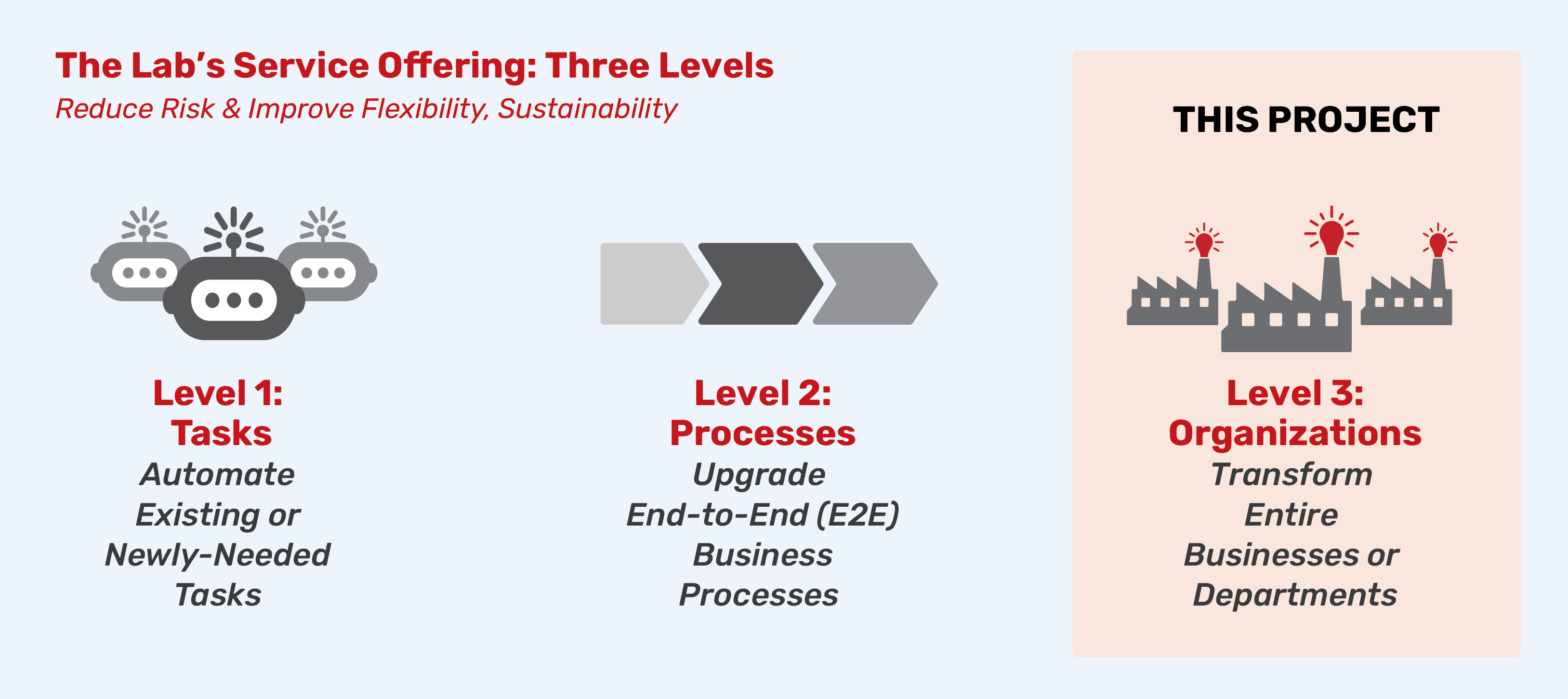
Tire Manufacturing Improvement Examples: Phase II, Standardization Implementation
The Lab documented more than 350 opportunities across the ten-plus business processes reviewed. Related improvements were organized into major implementation work streams, including the three examples below.
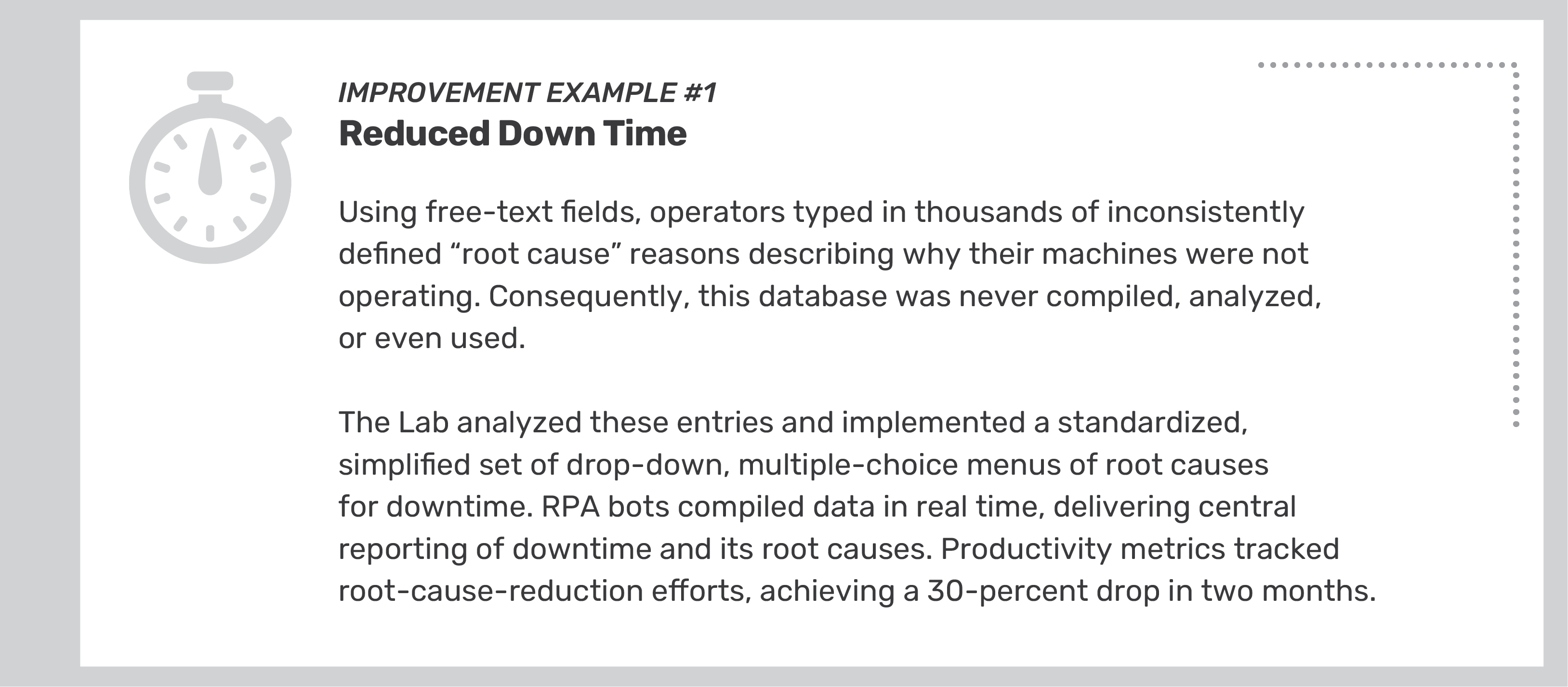
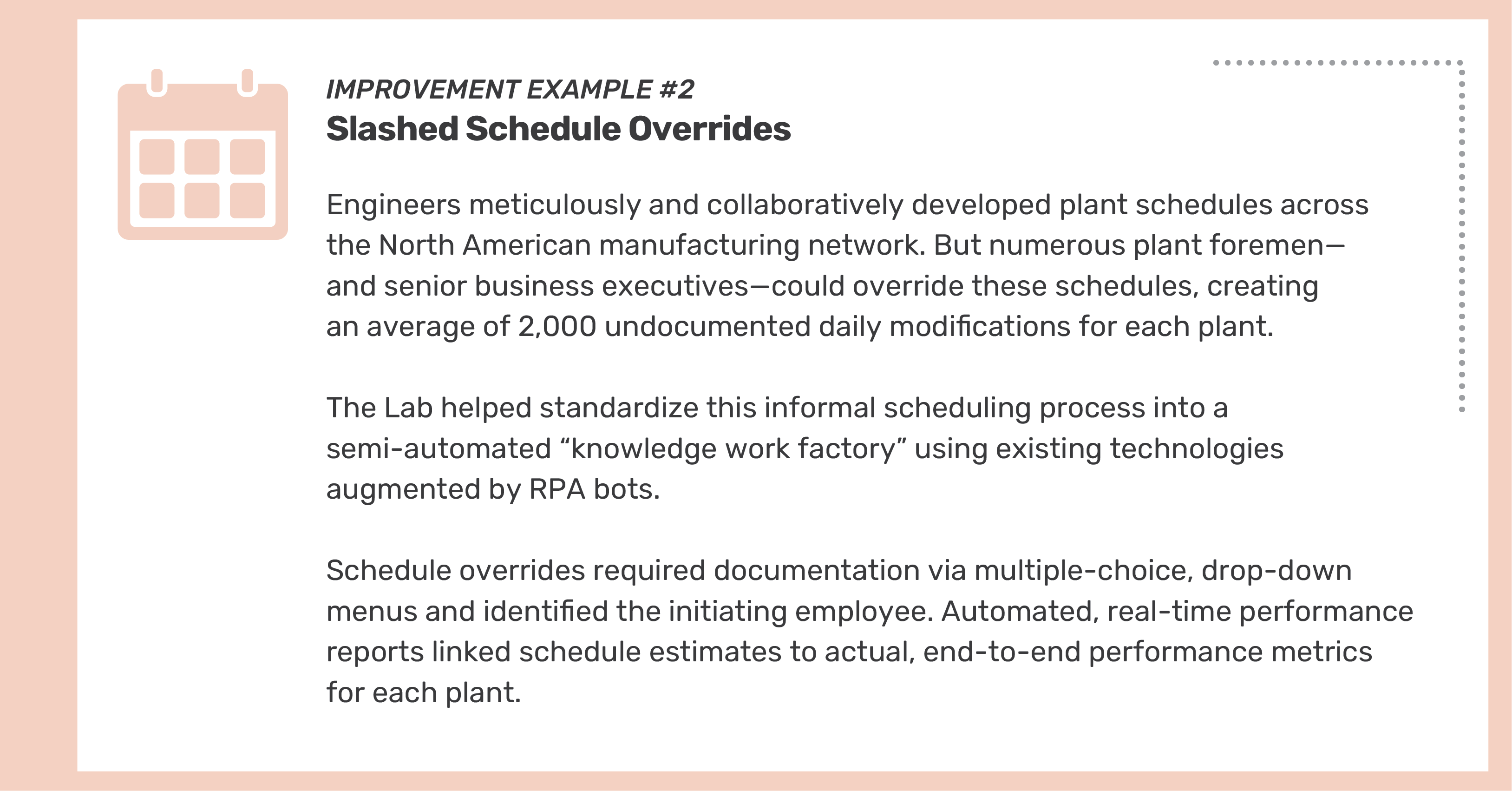
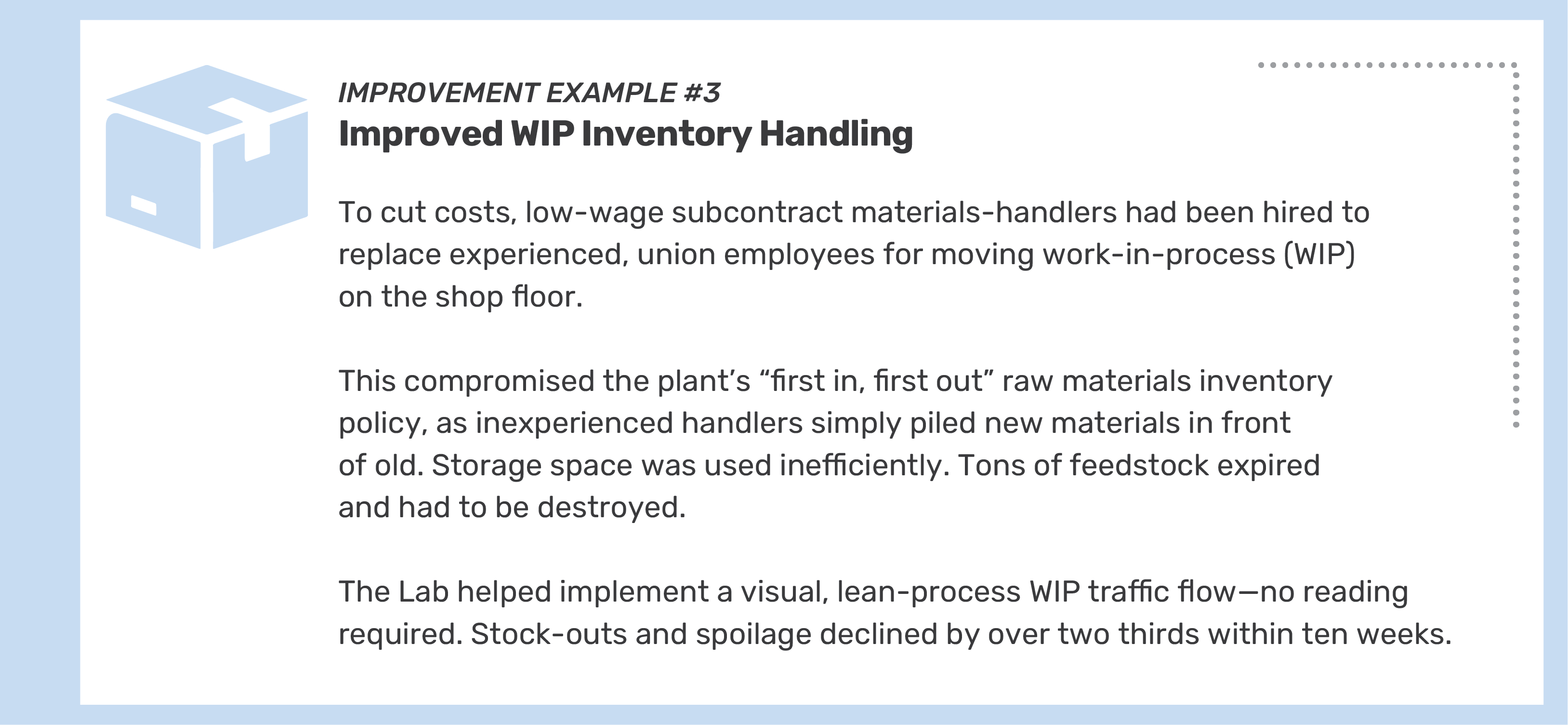
Post-Implementation Support, Sustainability & Automation
The Lab provided hassle-free, post-implementation hourly sustainability support for this client to maintain automations, process standardization, and operational data analytics models implemented during the Phase II engagement.
If the client’s team was not up-skilled enough to perform any needed automation updates, they leaned on The Lab for Tier 3-level support. If analytics dashboards required additional views or data connected, The Lab’s team was a simple phone call away.
The Lab Makes it Easy
Organization-friendly engagement design
At The Lab, we’ve spent three decades refining every aspect of our transformation engagement model. We’ve made it easy for clients—from the C-Suite to the front line—to understand and manage the initiative:
• Minimal use of client time: One to two hours each week, maximum.
• Measurable benefits: Typical 12-month ROI is 3x to 5x.
• Pre-built templates and tools: Process maps, data models, bots, and more.
• U.S.-based, remote delivery: Nothing is ever outsourced or offshored.
Designed to reduce risk, increase success
Since 1993, The Lab has led the industry in eliminating risk for our clients. Whether your engagement involves a handful of bots or wall-to-wall transformation, we make it easy to do business with us:
• Fixed pricing and clearly defined scope
• Pre-project feasibility/value assessments at nominal cost
• Early-out checkpoints and options
• Money-back guarantees
Book your free demo
The best way to learn about The Lab’s patented Knowledge Work Standardization® approach is to book your free, no-obligation 30-minute screen-sharing demo. And you’ll get all your questions answered by our friendly experts. Simply call (201) 526-1200 or email info@thelabconsulting.com to book your demo today!
















